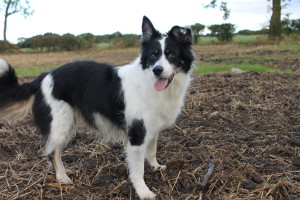Obsessive-Compulsive Disorder In Dogs.
We know that people can suffer from this debilitating disorder which can affect their lives in all sorts of negative ways, but is it possible for dogs to suffer from OCD too? Holidays4Dogs investigates whether dogs can suffer from obsessive-compulsive disorder.
Many owners, particularly those with herding and working breeds, will say that their dogs are ball, or toy-obsessed. However, this is not always to do with the kind of behaviour associated with true obsessive-compulsive disorder. Being always ready and happy to play with a ball, or toy, is a positive behaviour that can help with a dog’s well-being.
However, OCD behaviours, (or Canine Compulsive Behaviour – CCD), are usually exaggerated and sustained – disrupting normal behaviours and often instigated by conflict.
 Scientists have already discovered that OCD behaviours in humans and dogs are quite similar. Surprisingly, dogs will respond favourably to the same medications prescribed for humans. It has also been established that dogs, and people, share similar brain features and there is a genetic basis for the condition.
Scientists have already discovered that OCD behaviours in humans and dogs are quite similar. Surprisingly, dogs will respond favourably to the same medications prescribed for humans. It has also been established that dogs, and people, share similar brain features and there is a genetic basis for the condition.
Doberman Pinchers are the first breed of dog to show they have a genetic basis for canine compulsive disorder. By carrying out MRI scans, scientists discovered that dogs have similar brain structures to humans with OCD.
However, compulsive disorders manifest themselves in different ways in dogs, than they do in humans. Obsessive compulsiveness in dogs is consistent with their canine-specific behaviour.
Types of obsessive-compulsive behaviour in dogs
There are many different behaviours a dog may display if he is suffering from obsessive-compulsive disorder. The most common are;
- Tail chasing.
- Spinning, light/shadow chasing.
- Acral lick dermatitis – or lick granuloma (ALD).
- Self-mutilation.
- Air snapping.
- Flank sucking, sucking material or bedding.
- Licking objects.
- Persistent barking.
- Humping behaviour.
What does appear to be consistent, is that all behaviour associated with canine obsessive-compulsive behaviour results from stress, or conflict. The definition in veterinary literature states that this is only in the absence of neurological, dermatologic, or any other medical condition that may give rise to similar behaviour.
Although some breeds are predisposed to compulsive behaviour, such as those selectively bred herding or hunting – the majority of experts agree that stress is the main factor in cases of canine compulsive disorder.
Common triggers for canine compulsive disorder
- Isolation. Dogs that have been housed in stressful kennel conditions i.e. rescue dogs, puppy farms, or dogs belonging to animal ‘hoarders’.
- Conflict. Competition between dogs and threats to resources, such as food.
- Lack of opportunity for normal behaviour. Lack of exercise, overprotective owners.
- Constant changes in the dog’s environment. Unpredictable environments such as car journeys, and strange people visiting the house.
- It has been suggested human stress can also impact the dog’s behaviour.
- Diet may also be a contributing factor.
What can owners do to help obsessive-compulsive disorder in their dog?
If your dog is displaying canine compulsive behaviours in a way that you feel is repetitive, exaggerated and sustained – the most important thing is to rule out any other medical condition. Other health conditions, such as thyroid problems, may be creating stress in the dog. As a result, this may make the dog display compulsive behaviours. Therefore, you must seek veterinary advice as a first port of call.
Exercise
Ensure that your dog is getting enough daily exercise. Not only does exercise release ‘feel good’ hormones – just as it does in humans – taking your dog out regularly ensures he has mental stimulation too. Try and incorporate games and activities into daily exercise with your dog.
Training
Training and playing with your dog also helps to keep your dog active and balanced. Punishment creates nervous tension, so always avoid taking this approach and only employ positive reward-based methods.
Apply classical conditioning training or desensitisation techniques. Teach your dog something incompatible with the OC behaviour, for example chewing a toy, instead of licking paws.
Serious obsessive behaviour can be complicated to deal with. Therefore, you must get the correct advice – you should initially seek advice from your vet. After other medical conditions have been ruled out, your vet can refer you to a behaviourist.
Plug-in pheromones
Plug-in Dog Appeasing Pheromones (DAP diffusers) can be useful in alleviating stress and anxiety in dogs. Many people use these devices with a noticeable calming effect on their pets.
Environment
Manage your dog’s environment carefully so that he is less exposed to stress triggers. This may mean, not leaving him home alone for too long, or keeping him away from obvious sources of fear such as a bully dog, or a strange visitor to the house.
holidays4dogs.co.uk and 4Dogs are participants in the Amazon Services LLC Associates Program, an affiliate advertising program designed to provide a means for sites to earn commission fees by advertising and linking to the following websites. Read our full disclosure agreement here.


